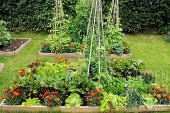Lisa Sture wrote:
Toko Aakster wrote:
It's about managing the land in such a way that your use of it is sustainable long-term... and even restorative.
=)
Thankyou for this lovely and thoughtful post. I like the sound of rivercane. I live in the UK and had never heard of it. I am wondering if some UK/EU folks have some good examples. We have lost a huge amount of our wetlands here - they are not even wet anymore. If someone has wet areas I can think of reeds and bulrushes for wet areas. Actually there are a lot of wetland plants that are edible as well.
The driest and dustiest areas are the farmed areas where the soil has died.
Your post has certainly given me food for thought.
There are comparable plants in most places - but a significant issue is that they do tend to proliferate, making them invasive.
The UK considers Phragmites australis a native reed, though it is acknowledged as invasive; some other sources give a different origin from central/southern Asia originally, but it's common enough worldwide now. Phragmites species are traditionally used for thatching in the UK and elsewhere, and work great as a thatching material.
The Strawbale Studio folks are very careful not to transport seeds when they use it for thatching demonstrations. Many Midwestern states are publishing information about how to get rid of it, how to distinguish it from the native Midwestern US version it is rapidly displacing. etc.
Phragmites are being credited with mitigating storm surge in the Missisippi delta, with uptaking excess nutrients, pulling down carbon, etc. in other research.
https://www.researchgate.net/figure/World-map-showing-the-distribution-of-Phragmites-australis-over-the-continents-Green_fig1_259103379
I'm often tempted to support the traditional craft materials that I might want to harvest. Yet in todays society with little time for traditional crafts, those plants may not be a good fit for a balanced, varied "zone 5." River grasses, reeds, and other prolific plants that can handle repeated harvesting for crafts do unfortunately also tend to be invasive - they are simply fecund, and that can become a mixed blessing (a solution looking for a problem becomes a problem...).
Even if they're locally native, not everyone is going to be happy about seeing them spreading everywhere:
https://www.lancaster.ac.uk/news/invasive-rushes-spreading-in-upland-farm-fields
Here's one site that shows many UK species for both wet and dry wildlife areas.
https://www.wildlifetrusts.org/wildlife-explorer/grasses-sedges-and-rushes/common-reed
You might want to find local experts for your specific area, since there's so much variety in soils and plants. A nearly identical site for the London wildlife trust:
https://www.wildlondon.org.uk/wildlife-explorer/grasses-sedges-and-rushes
Natural doesn't mean non-toxic, and native is not a guarantee that a plant is non-invasive or cooperative with other native species. I'll put an old favorite story about English ivy down below, for those who haven't heard it here before.
I spent a few years teaching people to weave baskets from English ivy, usually harvested on site - and then realized that when you teach people to use and love and harvest a plant, you don't get less of it - you get more, if they have any common sense. They get fond of it, and like to see it around, and notice if it's missing. So I started incorporating other common, less-invasive plants that are also great for weaving simple baskets, and encouraged people to 'graduate' from ivy if they ever had the lovely problem of ivy-free landscaping. The wild forage we used to harvest mostly didn't get exterminated by the people who ate and used it - very often, draining the marshes or enclosing the grazing meadows was a way of driving those people out, and taking over the land for an entirely different form of production. There are a few exceptions for rare medicinal plants of great value, but by and large the plants and animals that humans find most useful also tend to get rewarded by being spread, cultivated, and protected.
Not all grasses and reeds are prolific enough to tolerate extensive harvesting. The traditional basketry and thatch plants tend to be among the more prolific plants in an area. If you don't have a robust community of thatchers or weavers, maybe look at coddling some of the less-aggressive meadow plants, as a special pet, or finding out what sorts of insects and small animals are endangered in your area. A butterfly garden or songbird garden could be exquisite. Hedgerows have been a subject of conservation interest, as they often preserve last remnants of former forest expanses.
There sure are some beautiful plants out there for 'waste' land. Sometimes you can do better by getting a bucket of mud from a 'healthy' pond or marsh than by all the careful plant ID and expert advice.
https://www.wildlifetrusts.org/wildlife-explorer/grasses-sedges-and-rushes
...
The English Ivy story:
As with English ivy: it's terribly invasive here, and tends to cause our skinny deciduous trees to either die from being shaded out, or fall down due to having unaccustomed windage during winter storms when the soft soils are sodden. It also tends to out-grow our skinny coniferous trees. It is highly recommended to cut a foot-wide gap all the way around the tree so the stems die back, which reduces the amount of it seeding way up high; and on the ground, parties of volunteers and park staff will do "ivy rolls" where great mats of it are uprooted to make room for other plants. This is only practical where naturalists roughly outnumber the green spaces; in other areas, you just try to keep it from climbing everything in sight (it tends to seed from heights, so keeping it low also tends to confine the infestation instead of birds spreading it to new places).
So one day I called my English farmer great-uncle to see what kept it under control in England. As it turned out, he had recently taken a semi-retirement from farming, letting the farm rest as part of an environmental restoration program, so he was having this conversation a lot. Generally he was favorable to the program, but lamented the environmental students telling him not to cut back the English ivy because it is native and doesn't kill the trees ... "But it does kill the trees," he said with resignation.
Reflecting on all the holidays where ivy is peeled up, used to decorate, and then thrown on the fire - at least one per quarter of the year, more counting weddings - I concluded that the natural predator to keep English ivy in check is the English peasant. Or in my uncle's case, persistent gentleman farmer.
Yours,
Erica W






 25
25




 11
11




 12
12




 8
8






 5
5




 8
8




 7
7




 11
11




 9
9




 6
6




 7
7











